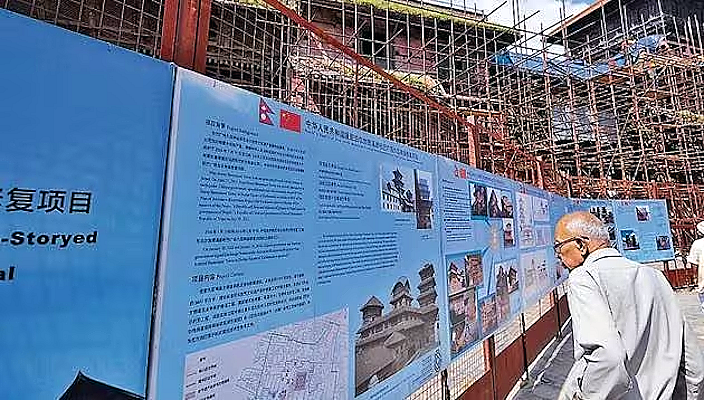
The China International Development Cooperation Agency (CIDCA) held the second China-Indian Ocean Forum in Kunming on December 8, 2023.
This year’s focus was “Boosting Sustainable Blue Economy to Build Together a Maritime Community with a Shared Future”.
Highlighting this, Luo Zhaohui, chairman of the CIDCA, said China was striving to further the United Nations Sustainable Development Goals and its own Global Development Initiative.
The blue economy, Luo said, would help Indian Ocean island countries achieve sustainable development.
The forum is one of China’s various initiatives to engage countries of the South Asian and Indian Ocean regions to consolidate and expand its strategic footprint, but India and Bhutan are not part of them.
This is one of Beijing’s attempts to set up parallel forums to challenge India’s primacy.
China has deeply engaged several South Asian countries through its Belt and Road Initiative projects and used its lending to prevent them from getting out of the agreements.
The Colombo Port city is a case in point. Yet some countries have curtailed investment after Sri Lanka defaulted and declared itself bankrupt.
For example, Pakistan scaled-down the Main Line 1 (ML-1) railway project, and Myanmar downsized Chinese investment in Kyaukphyu port.
Mapping the Indian Ocean
China’s forays into the Indian Ocean have increased in the recent past. It has been building ports in the region to bolster its maritime presence.
From insisting that China has no overseas ambition, it has a naval base in Djibouti and already has Hambantota port on a lease of 99 years.
Its “research” vessels that have been surveying the region like Shi Yan 1, Shi Yan 6, Yuan Wang 5, the ballistic missile and satellite tracking ship, Xiang Yang Hong 06 and spacecraft-tracking vessel and also a nuclear submarine, have docked both in Hambantota and Colombo Port Southern Container Terminal built by China in spite of India’s protest.
Ostensibly, the spy ship is engaged in deep marine research in the Indian Ocean in which some Sri Lankan locals participated.
China has recently asked for permission from Male and Colombo for the docking of another spy ship vessel, Xiang Yang Hong 03. Such activities have increased recently as China acquires new ports and bases.
The importance of the Indian Ocean as a major sea lane of communication and trade is well documented.
There is an argument that China’s increasing presence is to get out of its Melaka dilemma and ensure its trade is safe.
However, some think this Melaka dilemma proposition bolsters the country’s naval presence.
Over time, it has built Gwadar to have a strategic footprint and overcome its Melaka dilemma to build an overland pipeline to connect to China’s mainland through Pakistan.
However, its engagement in port-building activities gives China a strategic vantage point.
t has opened up a research centre at the University of Ruhuna in Matara, Sri Lanka, and also engaged in maritime research in the Maldives.
Regional diplomacy
How does this regional forum help further China’s interest in the region?
China is an observer in the Indian Ocean Rim Association with 23 member states and 11 dialogue partners, and the Indian Ocean Naval Symposium (IONS) consisting of 25 countries.
IONS is a regional forum for the navies of the Indian Ocean littoral to discuss maritime issues. In both these associations, India is one of the dominant players. China is also an observer in SAARC, like some other countries.
Since the launch of the BRI, China has made extra effort to connect with the South Asian region and set up parallel organisations to coordinate with other South Asian countries except India.
In July 2020, China held a video conference of foreign ministers from Afghanistan, Pakistan, Nepal and China to coordinate the Covid-19 efforts.
This was followed up in November 2020 with Chinese Vice Foreign Minister Luo Zhaohui’s video meeting with Afghanistan, Bangladesh, Nepal, Pakistan and Sri Lanka, in which they agreed to establish a centre for cooperation on poverty reduction and development.
During the Covid-19 pandemic in July 2021, the China-South Asia Emergency Supplies Reserve was to bring these five countries together again to emphasise its role in the region.
Interestingly, Maldives was not part of this initiative, given the previous Solih government’s approach to China.
China has persistently maintained that it wants to work with “these countries to resist illegal acts of interfering in other countries’ internal affairs and coercing other countries to choose sides”.
Perhaps this is one point that appeals to the countries looking for an alternative framework to dodge the interest of India, the United States and other Western countries.
Promising prosperity
China’s trade with South Asian countries has doubled in the past 10 years, with an annual growth of 8.3 percent.
Though this is minuscule compared to its global trade, China’s investment in South Asia has grown exponentially.
Its cumulative investment in the region is $15 billion, and the completed project contract turnover has exceeded $200 billion.
China would have a deep interest in South Asian politics as political upheaval would impact its investments.
In this context, the Indian Ocean is crucial in China’s overall approach to the region. For example, China imported 515.65 million tons of crude oil this year through the Indian Ocean, as per data from November.
Its vulnerability to any attack on its oil-carrying vessel is apparent.
To underline its presence, it has given names to nine under-seabed features.
Recently, the Chinese Defence and Foreign Ministers have made a point of visiting important Indian Ocean littorals where China has invested heavily and is looking for a strategic foothold.
It is not easy to wriggle out of an agreement on investment with Chinese capital, as Sri Lanka and Maldives learnt lately.
In times of economic crisis, China is reluctant to stand by its friends, as Sri Lanka’s economic crisis underscores. Yet the South Asian countries’ eagerness to play the China card has given Beijing a strategic opportunity.
ADVERTISEMENT
ADVERTISEMENT








































